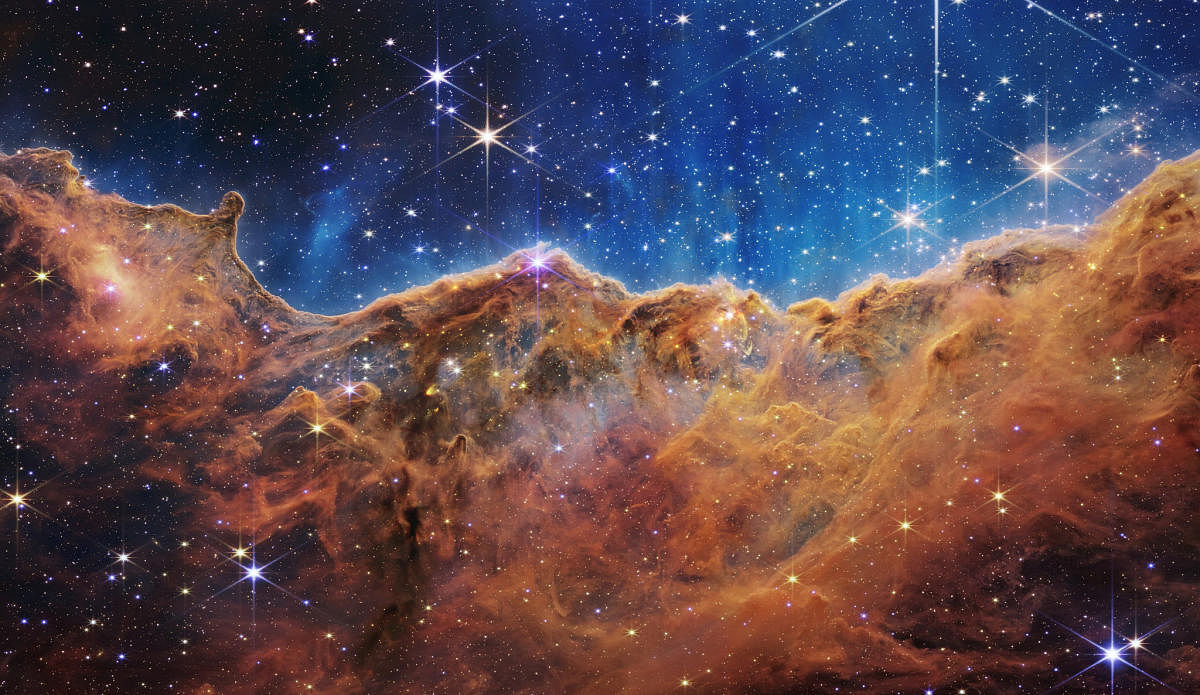
Artificial Intelligence storm
For millennia, art has been a pursuit unique to humankind. This year, however, machines have made their mark, and probably tease us with their interpretation of art. In April, artificial intelligence company OpenAI released DALL-E 2, a software that can generate digital images from word descriptors called “prompts”. In the following months, similar software took the art world by storm: while some were awed at these machine-generated art pieces, others questioned if it was the end of art as we know it. In September, an image generated using one such artificial intelligence-based text-to-art software even won first place in a digital arts competition! In November, OpenAI launched ChatGPT, an artificial intelligence-based chatbot that can converse like humans on chat, answer follow-up questions, admit mistakes and challenge incorrect premises.
Deflecting an asteroid with a thud
Our Earth gets hit by asteroids almost every day. We barely notice most of them as they burn in the atmosphere before making a dent. However, a few leave behind craters and a very small number can destroy much of the planet, like the one that struck Chicxulub 66 million years ago, killing three-fourths of all plants and animals, including the massive dinosaurs. This year, NASA’s Double Asteroid Redirection Test (DART) mission showed that if a planet-destroying asteroid were to head towards Earth, it could be deflected and its path changed. In September, the DART spacecraft crashed into Dimorphos, a smaller asteroid revolving around another bigger asteroid Didymos, and shortened its orbit.
Seeing the Universe with new eyes
Astronomy enthusiasts were delighted this year with spectacular views of the never-before-seen parts of the Universe captured by the James Webb Space Telescope. Launched in 2021, this largest optical telescope in space can “see” objects that are 100 times fainter than what its over-three-decades-old predecessor Hubble Space Telescope could. So far, the telescope has captured detailed images of young stars being formed, a snapshot of galaxies formed in the early Universe, interstellar gas and dust in the nebulae, planets and their moons of the Solar System, exoplanets and far-away galaxies.
Bacteria, visible to naked eyes, discovered
For centuries, bacteria have been thought to be microbes that can be seen only through a microscope. In June, the discovery of a new bacterium on the decaying leaves of mangroves in the swamps of Guadeloupe, Lesser Antilles, changed that view forever. Thiomargarita magnifica, a giant bacteria, is over 50 times bigger than other bacteria, and is visible to the naked eye. Unlike the free-floating DNA in other bacteria, this giant bacteria has its DNA in membrane-bound structures, as many other higher-level organisms do. Scientists believe that this discovery could mean there may be other bacteria hiding in plain sight, waiting to be discovered.
Pandemics shape our immunity for generations
In the last two years, the world reeled under the COVID-19 pandemic and is still recovering from the widespread suffering the virus caused. What comes out of such pandemics? A stronger immunity in our genes that is passed on for generations, find scientists. When they analysed the DNA of people who succumbed to the Black Death (aka bubonic plague), a disease caused by the bacterium Yersinia pestis that spread throughout Europe, the Middle East and Northern Africa between 1346-1350 and killed 30-50% of the people, they found little to no immunity to the bacterium. However, in the next 400 years, plague outbreaks did not kill as many people partly because our genes had evolved some immunity.
A viral source for multiple sclerosis
Multiple sclerosis, a progressive auto-immune disease impacting the brain, spinal cord and optic nerves, affects 2.8 million people worldwide. Among those with this condition, the immune system begins to attack the protective covering of the nerve cells, called the myelin sheath, and the affected nerves become slow or do not relay the messages as they should. Scientists do not yet understand what causes the immune system to go haywire. In January, a study showed that the Epstein-Barr virus, a common human herpes virus that causes mononucleosis and certain types of cancer could also be causing multiple sclerosis. Since there is no definitive cure for this condition yet, scientists believe targeting the virus, either through a vaccine or a drug, could help find a cure.
Blackhole at the centre of our galaxy snapped
In 2019, the Event Horizon Telescope created history by capturing the first-ever image of a black hole at the centre of the Messier 87 (M87) galaxy. In May of this year, the telescope revealed the image of Sagitarrius A* (Sgr A*, pronounced ‘sadge-ay-star’), a black hole at the centre of the Milky Way, confirming the long-held hypothesis of the presence of this black hole. The glowing doughnut-shaped ring of light is around 27,000 light years away from Earth, seething at 8 billion degrees Fahrenheit and about 4 million times the mass of the Sun.
Exascale supercomputer smashes records
In May, computer engineers revealed the world’s fastest supercomputer that is faster than the next seven best supercomputers combined. Frontier, as it is called, can perform more than a billion billion calculations per second. That is a whopping 1,100,000,000,000,000,000 complex operations (called FLOPS)! With such enormous power, scientists hope to use the supercomputer to better understand diseases like cancer, find new drugs, and simulate nuclear fusion experiments and cosmic activities like stellar explosions.
World’s oldest DNA provides peek into past
With climate change, the Arctic is warming four times faster than the rest of the world. But about two to three million years ago, now-polar-desert Greenland was warmer by 11–19 °C than it is today, with boreal forests home to poplar, birch and thuja trees, mastodons, reindeers, rodents, geese and hares, shows DNA extracted from organic-rich sediments at the Kap København Formation—a fossil-rich area in North Greenland. The study is the first to describe an ecosystem that is old with fair detail, showing how vital environment DNA could be in providing us with a glimpse of many ancient ecosystems.
Redefining death by reviving the dead
Death is typically described as a condition when blood circulation and oxygenation stop and the pulse hits zero. In May, however, a study on dead pigs questioned our understanding of death. Scientists showed that they could revive blood circulation and cellular activity in the heart and brain of a ‘dead’ pig even after an hour of death by using OrganEx, a system that pumps a solution of blood and 13 other compounds. This slowed decomposition and restored heart contraction and activities in the liver and kidneys. However, there was no brain activity that indicated the animals had regained consciousness.
